A) 30 cans of cola per chocolate bar
B) 10 cans of cola per chocolate bar
C) 3 cans of cola per chocolate bar
D) 1/3 can of cola per chocolate bar
F) B) and D)
Correct Answer

verified
Correct Answer
verified
True/False
As long as the marginal benefit from a good is greater than its marginal cost, an economy is operating efficiently.
B) False
Correct Answer

verified
Correct Answer
verified
Multiple Choice
The production possibilities frontier separates
A) the goods and services that people want from those that they do not want.
B) the types of goods that can be attained from those that can't be attained.
C) the quantities of goods and services that can be produced from those that cannot be produced.
D) the combinations of goods that people value and those that they don't.
F) A) and C)
Correct Answer

verified
Correct Answer
verified
Multiple Choice
On the vertical axis, the production possibilities frontier shows ________; on the horizontal axis, the production possibilities frontier shows ________.
A) the quantity of a good; the number of workers employed to produce the good
B) the quantity of a good; the price of the good
C) the quantity of a good; a weighted average of resources used to produce the good
D) the quantity of one good; the quantity of another good
F) A) and C)
Correct Answer

verified
Correct Answer
verified
Multiple Choice
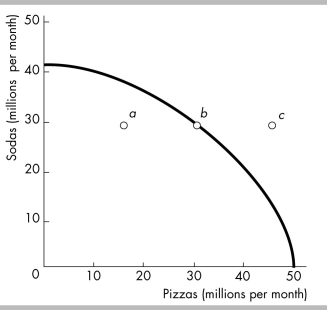 -A PPF, such as the one above, that bows outward illustrates
-A PPF, such as the one above, that bows outward illustrates
A) decreasing opportunity cost.
B) increasing opportunity cost.
C) that technology is improving.
D) that productivity is falling.
F) C) and D)
Correct Answer

verified
Correct Answer
verified
Multiple Choice
In order to societies to reap the gains from trade, it is necessary to
A) define and enforce property rights.
B) foster economic growth.
C) distribute resources equally.
D) achieve productive efficiency.
F) None of the above
Correct Answer

verified
Correct Answer
verified
Multiple Choice
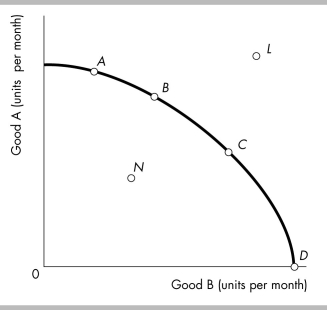 -In the above figure, which point represents an unattainable production combination of the two goods?
-In the above figure, which point represents an unattainable production combination of the two goods?
A) point C
B) point L
C) point D
D) point N
F) C) and D)
Correct Answer

verified
Correct Answer
verified
Multiple Choice
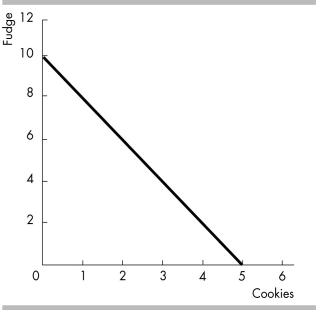 -The figure above shows Freda's PPF. Freda currently produces 10 packets of fudge and no cookies. If Freda decides to produce 1 packet of cookies, her opportunity cost of the packet of cookies is ________ of fudge.
-The figure above shows Freda's PPF. Freda currently produces 10 packets of fudge and no cookies. If Freda decides to produce 1 packet of cookies, her opportunity cost of the packet of cookies is ________ of fudge.
A) 1 packet
B) 1/2 packet
C) 2 packets
D) 0 packets
F) A) and C)
Correct Answer

verified
Correct Answer
verified
Multiple Choice
 -Refer to the production possibilities frontier in the figure above. If the country moves from point a to point c, the opportunity cost of the move is
-Refer to the production possibilities frontier in the figure above. If the country moves from point a to point c, the opportunity cost of the move is
A) 30 million capital goods.
B) 20 million capital goods.
C) 10 million capital goods.
D) 10 million consumption goods.
F) A) and B)
Correct Answer

verified
Correct Answer
verified
Multiple Choice
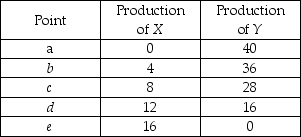 -Refer to the table above, which gives five points on a nation's PPF. The production of 7 units of X and 28 units of Y is
-Refer to the table above, which gives five points on a nation's PPF. The production of 7 units of X and 28 units of Y is
A) impossible given the available resources.
B) possible but leaves some resources less than fully used or misallocated.
C) on the production possibilities frontier between points c and d.
D) on the production possibilities frontier between points b and c.
F) All of the above
Correct Answer

verified
Correct Answer
verified
Multiple Choice
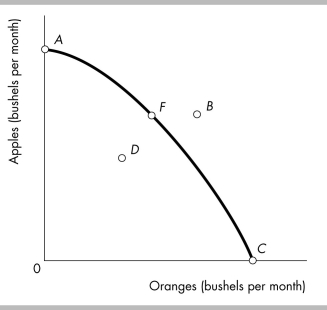 -In the figure above, what can be said about point B?
-In the figure above, what can be said about point B?
A) It can be reached only after economic growth occurs.
B) It can be attained only if some resources are left unused.
C) It represents all resources being devoted to the production of apples.
D) It represents all resources being devoted to the production of oranges.
F) A) and B)
Correct Answer

verified
Correct Answer
verified
Multiple Choice
When resources are assigned to inappropriate tasks, that is, tasks for which they are not the best match, the result will be producing at a point
A) where the slope of the PPF is positive.
B) where the slope of the PPF is zero.
C) inside the PPF.
D) outside the PPF.
F) All of the above
Correct Answer

verified
Correct Answer
verified
Multiple Choice
In one day, Brandon can either plow 10 acres or plant 20 acres. In one day, Christopher can either plow 14 acres or plant 14 acres. Which of the following statements about comparative advantage is CORRECT?
A) Brandon has a comparative advantage in both plowing and planting.
B) Brandon has a comparative advantage only in plowing.
C) Brandon has a comparative advantage only in planting.
D) Christopher has a comparative advantage in both plowing and planting.
F) B) and C)
Correct Answer

verified
Correct Answer
verified
Multiple Choice
Which of the following statements regarding the production possibilities frontier is TRUE?
A) Points outside the frontier are attainable.
B) Points inside the frontier are attainable.
C) Points on the frontier are less efficient than points inside the frontier.
D) None of the above because all of the above statements are false.
F) A) and C)
Correct Answer

verified
Correct Answer
verified
Multiple Choice
The principle of increasing opportunity cost leads to
A) a production possibilities frontier (PPF) that is bowed inward from the origin.
B) a production possibilities frontier (PPF) that is bowed outward from the origin.
C) an inward shift of the production possibilities frontier (PPF) .
D) an outward shift of the production possibilities frontier (PPF) .
F) A) and D)
Correct Answer

verified
Correct Answer
verified
Multiple Choice
When an economy produces at its allocatively efficient production point
A) scarcity is not a problem.
B) resources are not limited.
C) a society can increase the production of all goods.
D) a society can increase the production of one good only by decreasing the production of some other good that is valued more highly.
F) B) and C)
Correct Answer

verified
Correct Answer
verified
Multiple Choice
The idea of comparative advantage implies that people or countries
A) should specialize in the production of goods.
B) can gain from trading.
C) can consume at a point outside their production possibilities frontier.
D) all of the above.
F) B) and C)
Correct Answer

verified
Correct Answer
verified
Multiple Choice
Moving along a PPF, marginal cost is
A) the cost of producing the first unit of a good or service.
B) the total cost, less the production of the other good or service.
C) greater than the opportunity cost.
D) equal to the opportunity cost of producing one more unit of a good or service.
F) A) and C)
Correct Answer

verified
Correct Answer
verified
Multiple Choice
Suppose that a typical German factory can produce 20 cameras or 1 computer in an hour, and that a typical American factory can produce 10 cameras or 1 computer in an hour. The opportunity cost of 20 cameras in terms of computers in Germany is
A) 10 computers per camera.
B) 2 computers per camera.
C) 1 computer per camera.
D) 1/20 of a computer per camera.
F) B) and D)
Correct Answer

verified
Correct Answer
verified
Multiple Choice
The principle of decreasing marginal benefit implies that the
A) additional benefit from obtaining one more of a good or service decreases as more is consumed.
B) additional benefit from obtaining one more of a good or service increases as more is consumed.
C) total benefit from obtaining more of a good or service decreases as more is consumed.
D) total benefit from obtaining more of a good or service remains the same as more is consumed.
F) A) and D)
Correct Answer

verified
Correct Answer
verified
Showing 161 - 180 of 443
Related Exams